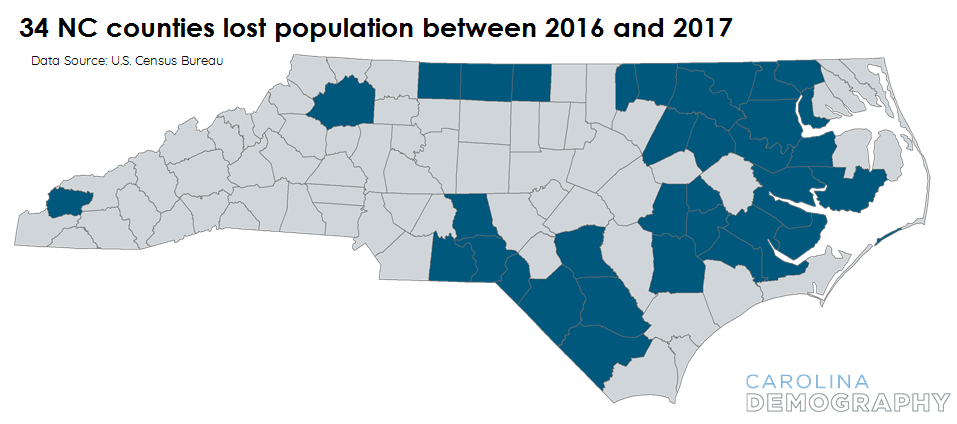Are NC county growth patterns shifting?

North Carolina’s population grew by 1.1% between July 1, 2016 and July 1, 2017, gaining nearly 117,000 new residents over the year. New estimates from the U.S. Census Bureau provide detail on how this growth and change occurred across the state. In North Carolina, these estimates indicate emerging trends that we will continue to examine in the coming months. For now, here’s what you need to know about the data.
During the first half of the decade, more than half (53%) of the state’s growth occurred in one of three counties: Wake, Mecklenburg, and Durham. While these counties continue to grow steadily, together they accounted for just 40% of statewide growth in 2016-17, thirteen percentage points less than their share of growth during 2010-15. Population growth is now occurring more broadly across the state. The 2017 estimates suggest a return to pre-recession growth patterns, with growth shifting to suburban and exurban counties more than occurred during the first half of the decade.
Brunswick County remains the state’s fastest-growing county, growing by an estimated 3.6% or more than 4,500 residents between July 1, 2016 and July 1, 2017. Nearby Pender County grew nearly as rapidly (3.5%), highlighting overall strong growth in Wilmington (New Hanover) and its adjacent counties.
Brunswick, as well as Chatham and Clay counties, have strong appeal to retirees. While this older population caused them to have more deaths than births last year (negative natural increase or natural decrease), these losses were more than offset by the large gains from net in-migration.
Many of the remaining counties in the top 10 are suburban counties in the Charlotte (Cabarrus, Union) and Triangle (Johnston, Franklin) metro areas. For the first time this decade, Mecklenburg is not among the top 10 fastest growing counties and Wake is outside of the top 5.
Nearly one in three North Carolina counties had larger population increases between July 1, 2016 and July 1, 2017 than any year since 2010. With two exceptions—Forsyth County (Winston-Salem) and New Hanover County (Wilmington)—none of these 32 counties contained the principal city of a metropolitan area.
In many counties, the 2017 estimates mark a significant increase in growth. Alamance County, for example, gained an estimated 3,100 new residents during 2017. This was an increase of more than 1,000 over estimated growth during 2016. In Mitchell County, last year’s estimated growth was small (+4) but marked the first year of non-negative growth since 2010.
Population decline remains a challenge for many North Carolina counties. Thirty-four counties had fewer residents in 2017 than in 2016—all of these counties have fewer residents today than they did in 2010.
Cumberland and Robeson counties had the largest numeric losses over the year: each county had an estimated loss of nearly 1,000 residents. Halifax, Lenoir, Edgecombe, and Duplin each lost an estimated 500-600 residents over 2016-17. The largest percentage declines were in Hyde (-2.1%) and Northampton (-1.5%) counties.
These estimates offered the first comprehensive look at county population since the impact of Hurricane Matthew in 2016. Most of the counties with the largest population losses were significantly impacted by the storm. However, most of these counties have also had steady population losses since 2010; the 2017 estimates are generally consistent with these broader trends.
It is impossible to tell what might have happened in these counties had Hurricane Matthew not occurred. Would these counties also have benefited from the broader growth patterns observed in other parts of the state during 2017? Alternatively, it may be that the population impacts of the storm are not easily measured at the county level. The municipal estimates scheduled for release in late May will provide another opportunity to further evaluate population shifts in the aftermath of Hurricane Matthew.
Need help understanding population change and its impacts on your community or business? Carolina Demography offers demographic research tailored to your needs.
Contact us today for a free initial consultation.
Contact UsCategories: Carolina Demographics
Tags: Hurricane Matthew, metro areas, population estimates, population growth, U.S. Census Bureau

The Center for Women’s Health Research (CWHR) at the University of North Carolina School of Medicine released the 12th edition of our North Carolina Women’s Health Report Card on May 9, 2022. This document is a progress report on the…

Dr. Krista Perreira is a health economist who studies disparities in health, education, and economic well-being. In collaboration with the Urban Institute, she recently co-led a study funded by the Kate B. Reynolds Foundation to study barriers to access to…

Our material helped the NC Local News Lab Fund better understand and then prioritize their funding to better serve existing and future grant recipients in North Carolina. The North Carolina Local News Lab Fund was established in 2017 to strengthen…
Your support is critical to our mission of measuring, understanding, and predicting population change and its impact. Donate to Carolina Demography today.